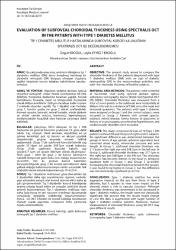EVALUATION OF SUBFOVEAL CHOROIDAL THICKNESS USING SPECTRALIS OCT IN THE PATIENTS WITH TYPE 1 DIABETES MELLITUS
Abstract
OBJECTIVE: The present study aimed to compare the choroidal thickness of the patients diagnosed with type 1 diabetes mellitus (DM) with no sign of diabetic retinopathty (DR) in the endocrinology policlinic and with the choroidal thickness of healthy subjects. MATERIAL AND METHODS: The patients were screened at horizontal level using spectral domain optical coherence tomography device (Nidek SLO/Spectral OCT (RS 3000)). Choroidal thickness was measured from a total of seven points in the subfoveal area horizontally at 600?m intervals to a distance of 1200 ?m in the nasal and temporal quadrants. The patients with type 1 diabetes were assigned to Group 1 and the control subjects were assigned to Group 2. Patients with corneal opacity, cataract, retinal disease, family history of glaucoma or history of ocular surgery, uncontrolled hypertension, and cardiovascular disorders were excluded. RESULTS: The study comprised 20 eyes of 10 Type 1 DM patients without DR and 16 eyes of eight control subjects. No significant difference was determined between the groups in terms of age, gender, spherical equivalent, best corrected visual acuity, intraocular pressure and axial length. In Group 1, subfoveal choroidal thickness was 311.6?m in the right eye and 348.7?m in the left eye. In Group 2, subfoveal choroidal thickness was 377.1?m in the right eye and 368.9?m in the left eye. The choroidal thickness has become thinner in the nasal vs. temporal quadrant both in Group 1 and Group 2 (p=0.039). Comparing the choroidal thickness between the groups, it was found to be higher in Group 2, but the difference was not statistically significant (p=0.214). CONCLUSIONS: Type 1 diabetes mellitus has more aggressive impacts on the eye than those of type 2 diabetes, but it appears to have lower impact on the choroid, which is rich in vascular structure. Although choroidal thickness was determined to be decreased in type 1 diabetes mellitus, the results were not statistically significant. We assume that the results might change in case the data is augmented with larger number of type 1 diabetes mellitus patients. Moreover, manual measurement of choroidal thickness using SD-OCT may give different results. AMAÇ: Bu çalışmada amacımız, endokrin kliniğince tip 1 diyabetes mellitus (DM) tanısı konulmuş herhangi bir diyabetik retinopati (DR) bulgusu olmayan olgularla, sağlıklı bireylerin koroid tabakası kalınlıklarını karşılaş-tırmaktır. GEREÇ VE YÖNTEM: Olguların spektral domain optical chorence tomografi cihazı (Nidek SLO/Spectral OCT(RS 3000))ile horizontal düzlemde taraması yapıldı. Koroid kalınlıklarını foveada, nazal ve temporalde horizontal olarak 600?m aralıklarla 1200 ?m mesafaye kadar toplam 7 noktada ölçümler yapıldı. Tip 1 diyabet olan hastalar grup 1, kontrol grubu ise grup 2 olarak sınıflandırıldı. Korneal opasite, katarakt, retinal hastalık, ailede glokom ve oküler cerrahi öyküsü, kontrolsüz hipertansiyon, kardiyovasküler bozukluk olan hastalar çalışmaya dahil edilmedi. BULGULAR: Çalışmaya DR’si olmayan 10 tip 1 DM hastasının 20 gözü ile 8 kontrol grubunun 16 gözü dahil edildi. Yaş, cinsiyet, sferik ekivalan, düzeltilmiş en iyi görme keskinliği, göz içi basıncı ve aksiyel uzunluk değerlerinde gruplar arasında anlamlı farklılık saptanmadı. (Grup 1)’de subfoveal koroidal kalınlık sağ gözde 311.6?m sol gözde 348.7?m olarak bulundu. (Grup 2)’de subfoveal koroidal kalınlık sağ gözde377.1?m sol gözde 368.9?m olarak ölçülmüştür. Hem grup 1 hem de grup 2 de koroid kalınlığının nazalde temporale göre daha ince olduğu bulunmuştur (p=0.039). Her iki grubun koroid kalınlıkları karşılaştırıldığında grup 2 de koroid kalınlıklarının daha yüksek olduğu bulunmasına karşın veriler arasındaki fark istatistiki olarak anlamlı bulunmamıştır (P=0.214).SONUÇ: Tip 1 diyabetes mellitusun göze olan etkileri tip 2 diyabetten daha ağır seyretmesine rağmen, vasküler yapı yönünden zengin olan koroid üzerine etkisi daha az gibi görünmektedir. Tip 1 diyabette koroid kalınlığında azalma olduğu tespit edilse de sonuçlar istatistiki olarak anlamlı bulunmamıştır. Tip 1 diyabetes mellitusu olan daha fazla hasta ile veri sayısının artırılması durumunda sonuçlarda değişiklik olabileceği düşünülmektedir. Ayrıca SD-OKT cihazları ile koroid kalınlığı ölçümünün manuel olarak yapılması sonuçların farklı çıkmasına neden olabilmektedir.
















